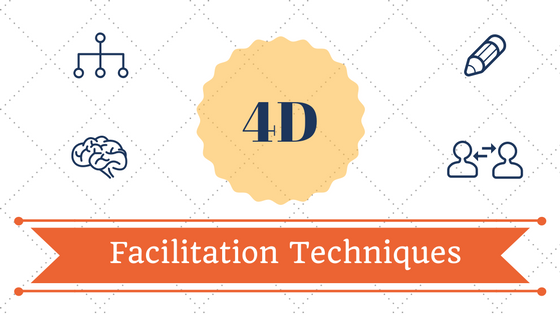Four-dimensional facilitation techniques

To support groups in creating such outcomes, facilitators have developed and documented many different techniques for brainstorming, discussion and decision making. There are numerous libraries with such techniques. However, these techniques are typically not a one-size-fits-all solution. In most cases, facilitators adapt the tools to match the group, the task and the context in which they facilitate a collaboration process.
As a researcher, I have been looking for the essential elements of facilitation interventions. The more precise we can narrow down and document the intervention, the better we can predict their effects and, more important, their effectiveness. In this process I stumbled on a conceptual understanding of facilitation techniques in four dimensions. I compare them to pasta. Pasta can be made of different ingredients; flour, but also from potatoes, rice, and various other grains. Pasta can have different structures, spaghetti, penne, gnocchi, etc. Pasta can be processed in different ways, fresh, dried, cooked, baked in the oven, etc. Finally, pasta can be combined with other ingredients in different ways. It can be combined with a sauce, stuffed with meat or cheese, or layered like lasagna. All these aspects of pasta can be combined in many different ways, to create an endless variation of dishes. For facilitation techniques I created a similar system.

The ingredients of facilitation techniques are the type of input we work with. Many facilitation techniques are text based, when we brainstorm ideas, or share lessons learned, but we could also use sketching, model elements, numbers or stories as input for our facilitation technique. Visualization can be very powerful to support creativity, but also to develop shared understanding.
The structure of the facilitation techniques is the way we structure information. We can work in a list on a flip chart, but also in a mind-map structure, in a matrix model or in different categories. Depending on the complexity of the problem a different structure is suited to support the group in analyzing the problem and identifying a solution.
The facilitation techniques can also support different phases of information processing. We can share information, brainstorm ideas, structure or organize concepts, vote about information, revise and improve it, and make decision based on the information shared by the group. In this way, we can develop a process in which the group solved a problem in a sequence of steps.
Finally, facilitation techniques can be used in different modes of interaction. We can do some steps of a collaboration process in a plenary session, while others are better done individually, in a relay fashion, in small groups or in pairs. There are many ways to organize the interaction, and each has different impact on the quality of the results and the support for the outcomes.
With these four dimensions you can compose effective collaboration techniques that fit the task, the group, the process and the complexity of the context. With these techniques you develop the process required for the group to accomplish their task. However, you need two additional ingredients to finish your facilitation technique. First you need to formulate the question or instruction for each step. What is it the group needs to brainstorm, on what criteria do they decide, or on which topics will they need to find common ground and a shared vision. Second, you need to fill in the tools or materials to support the interactive technique. You could brainstorm ideas on yellow stickies’, but you can also type them in a shared document or chat tool. Different tools can be used to implement these facilitation techniques to support collaboration face-to-face or online.
We thank Gwendolyn for sharing this insight with us and invite you to share your opinions about this framework in the comments. If you are looking for methods you can use to build an effective collaboration check out the SessionLab Library of facilitation techniques.



Leave a Comment